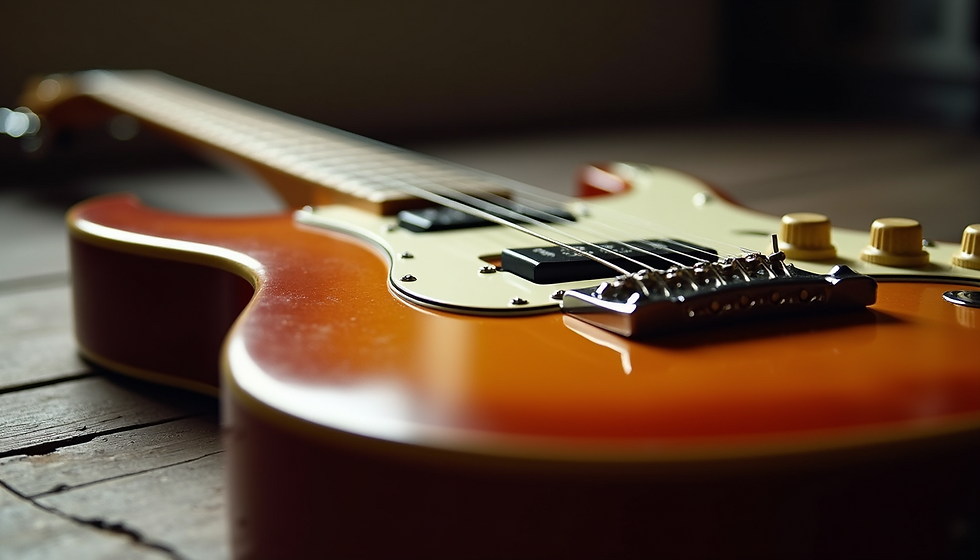Unlocking the Secrets of Bass Guitar Playing
- WoodysMusic
- Sep 4
- 4 min read
Playing the bass guitar is a unique and rewarding experience. It forms the backbone of many musical genres, providing rhythm and depth that other instruments build upon. Whether you are a beginner or looking to refine your skills, understanding the essentials of bass guitar playing can elevate your music to new heights. This guide will walk you through the key aspects of mastering this instrument, from foundational techniques to understanding its role in a band.
Understanding Bass Guitar Essentials
Before diving into complex techniques, it’s important to grasp the basics of the instrument. The bass guitar typically has four strings, tuned an octave lower than a standard guitar. This lower pitch gives it a deep, rich sound that supports the harmony and rhythm of a song.
Key Components of the Bass Guitar
Body and Neck: The body shape affects comfort and tone, while the neck length influences playability.
Strings: Usually thicker than guitar strings, they produce lower frequencies.
Pickups: These convert string vibrations into electrical signals, shaping the instrument’s tone.
Bridge and Tuning Pegs: Essential for maintaining string tension and tuning stability.
Basic Playing Techniques
Fingerstyle: Using your index and middle fingers to pluck the strings, offering a warm, natural tone.
Slap and Pop: A percussive technique that adds funk and groove.
Using a Pick: Produces a sharper, more aggressive sound, common in rock and punk genres.
Practice Tips
Start slow and focus on clean, consistent notes.
Use a metronome to develop timing and rhythm.
Practice scales and simple bass lines to build finger strength and dexterity.

Close-up view of bass guitar strings and pickups
Essential Gear and Accessories for Bass Guitar Players
Having the right gear can make a significant difference in your playing experience and sound quality. Here are some essentials every bass player should consider:
Amplifiers
A good amplifier is crucial for projecting your sound. Look for one with adjustable EQ settings to shape your tone. Practice amps are perfect for beginners, while gigging musicians may need more powerful models.
Effects Pedals
Effects like compression, overdrive, and chorus can add texture and character to your playing. Experiment with different pedals to find your unique sound.
Strings and Maintenance
Regularly changing your strings keeps your instrument sounding fresh. Clean your bass after each session to prevent buildup and corrosion.
Accessories
Tuner: Essential for keeping your instrument in tune.
Strap: Choose a comfortable strap for long playing sessions.
Cables: Invest in quality cables to avoid signal loss and noise.

Eye-level view of bass guitar amplifier and effects pedals
What's the difference between a guitar and a bass guitar?
Understanding the differences between a guitar and a bass guitar is fundamental for anyone interested in string instruments. While they may look similar, their roles and construction vary significantly.
String Count and Tuning
Guitar: Typically has six strings tuned to E-A-D-G-B-E.
Bass Guitar: Usually has four strings tuned to E-A-D-G, one octave lower.
Role in Music
Guitar: Often plays chords, melodies, and solos.
Bass Guitar: Focuses on rhythm and harmony, locking in with the drums to form the groove.
Physical Differences
Neck Length: Bass guitars have longer necks to accommodate lower notes.
String Thickness: Bass strings are thicker to produce deeper sounds.
Body Size: Bass guitars are generally larger and heavier.
Playing Techniques
Guitarists often use picks or fingerpicking for melodic lines.
Bassists emphasize fingerstyle, slapping, and popping to create rhythmic patterns.
Understanding these differences helps players appreciate the unique contribution of each instrument in a band setting.

High angle view of guitar and bass guitar side by side
Developing Your Bass Guitar Playing Skills
Improving your bass playing requires consistent practice and a focus on several key areas:
Timing and Rhythm
The bass guitar is the bridge between rhythm and melody. Developing a strong sense of timing is essential. Use a metronome and play along with drum tracks to internalize beats.
Finger Strength and Dexterity
Exercises like scales, arpeggios, and finger independence drills help build the necessary strength and agility.
Listening and Learning
Study bass lines from various genres. Try to replicate them and understand their role in the song. This will expand your musical vocabulary and inspire creativity.
Playing with Others
Jam sessions and band practice are invaluable. They teach you how to lock in with other musicians and adapt your playing dynamically.
Recording Yourself
Recording your practice sessions allows you to hear your progress and identify areas for improvement.
Exploring Different Styles and Genres
The bass guitar is versatile and appears in many musical styles. Exploring different genres can broaden your skills and keep your playing fresh.
Rock and Pop
Focus on steady, driving bass lines that support the song’s energy.
Jazz
Emphasizes walking bass lines and improvisation, requiring a good understanding of music theory.
Funk
Involves slap and pop techniques, syncopated rhythms, and groove.
Blues
Often uses simple, repetitive patterns with expressive bends and slides.
Reggae
Features offbeat rhythms and a laid-back feel.
Experimenting with these styles will help you find your unique voice on the instrument.
Taking Your Bass Guitar Journey Further
Mastering the bass guitar is a continuous journey. Here are some tips to keep progressing:
Set Goals: Define what you want to achieve, whether it’s learning a song, mastering a technique, or performing live.
Seek Feedback: Join online forums, take lessons, or find a mentor.
Stay Inspired: Listen to great bass players like James Jamerson, Flea, or Victor Wooten.
Keep Practicing: Consistency is key to improvement.
For those looking to get started or upgrade their instrument, consider exploring options at a trusted music store. A quality bass guitar can make all the difference in your playing experience.
Unlocking the secrets of bass guitar playing opens up a world of musical possibilities. With dedication and the right approach, you can become a confident and creative bassist, ready to contribute to any musical setting.



